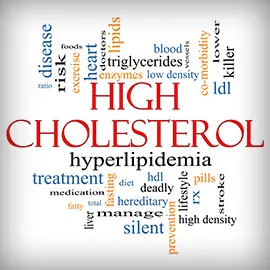Understanding Hyperlipidemia
 In small quantities, fat is useful to our health. Unfortunately, we often eat more fat than necessary for benefits like nutrient absorption and joint protection. Our bodies do what they can to push excess fat into storage, leading to weight gain, but often the excess fat will also build-up in the blood stream.
In small quantities, fat is useful to our health. Unfortunately, we often eat more fat than necessary for benefits like nutrient absorption and joint protection. Our bodies do what they can to push excess fat into storage, leading to weight gain, but often the excess fat will also build-up in the blood stream.
This may lead to unhealthy blood levels of fats or lipids such as cholesterol and triglycerides. When this occurs, the condition is known as hyperlipidemia.
What is Cholesterol?
Cholesterol is a form of fat that the body naturally produces to help with certain functions. It travels in our blood to help create hormones, transport vitamins and even help with the digestion and breakdown of nutrients.
There are two forms of cholesterol:
- LDL or low-density lipoproteins: This is the “bad” cholesterol. This form of cholesterol builds-up in your arteries, preventing optimal blood flow from your heart to other areas of your body.
- HDL or high-density lipoproteins: This is “good” cholesterol, and it is what transports cholesterol from other parts of your body to your liver where it can be discarded.
Hyperlipidemia is partially caused by “high cholesterol.” This develops when there is too much LDL cholesterol in the blood-stream. Cholesterol contributes to the build-up of plaque in the arteries, a substance that hardens and ultimately narrows the blood vessels preventing blood getting to vital organs such as your heart and brain High levels of LDL cholesterol increase your risk for heart disease and stroke.
In contrast to LDL cholesterol, high levels of HDL cholesterol can actually reduce your risk of heart disease, as it promotes the excretion of cholesterol from the body. Low levels of HDL cholesterol will also contribute to hyperlipidemia.
What are Triglycerides?
Triglicerides are the other component of hyperlipidemia. They are a type of fat found in the blood that the body uses for energy. When triglyceride levels become too high they contribute to the formation of plaque in the arteries. High triglyceride levels will increase your risk for heart disease.
Measuring Cholesterol and Triglycerides
Hyperlipidemia is diagnosed through a blood test called a lipid profile that evaluates the level of lipids, or fat, in the blood. A single blood test can report levels of cholesterol and triglycerides. These levels are then assessed on the following scales:
Range of optimal cholesterol levels:
- Total cholesterol should be less than 200 mg/dL
- LDL cholesterol should be less than 100 mg/dL
- HDL cholesterol should be greater than 60 mg/dL
Range of optimal triglycerides:
- Less than 150 is normal
- 150 – 199 is borderline high
- 200 – 499 is high
- 500 or higher is very high
Treatment for Hyperlipidemia
Because cholesterol is manufactured in the body, dietary restrictions may not be sufficient to control LDL cholesterol. Medications are often prescribed to help manage the level of fats in the blood. In many cases, however, hyperlipidemia can be managed with weight control, eating a healthy diet and engaging in regular physical activity.
Many people experience improvements to their cholesterol and triglyceride levels during a medical weight loss program, and are able to reduce or eliminate their need for cholesterol medications as a result. Treatment for hyperlipidemia is viewed as a preventative measure against coronary heart disease and stroke.
